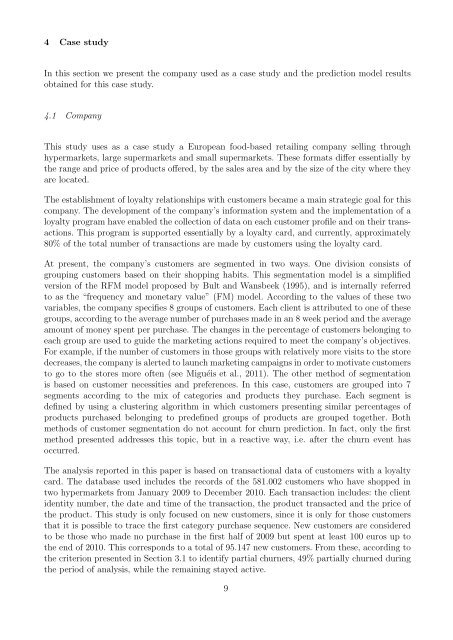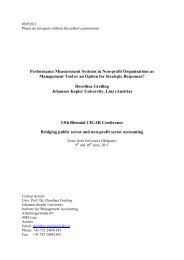Predicting Partial Customer Churn Using Markov for Discrimination ...
Predicting Partial Customer Churn Using Markov for Discrimination ...
Predicting Partial Customer Churn Using Markov for Discrimination ...
You also want an ePaper? Increase the reach of your titles
YUMPU automatically turns print PDFs into web optimized ePapers that Google loves.
4 Case study<br />
In this section we present the company used as a case study and the prediction model results<br />
obtained <strong>for</strong> this case study.<br />
4.1 Company<br />
This study uses as a case study a European food-based retailing company selling through<br />
hypermarkets, large supermarkets and small supermarkets. These <strong>for</strong>mats differ essentially by<br />
the range and price of products offered, by the sales area and by the size of the city where they<br />
are located.<br />
The establishment of loyalty relationships with customers became a main strategic goal <strong>for</strong> this<br />
company. The development of the company’s in<strong>for</strong>mation system and the implementation of a<br />
loyalty program have enabled the collection of data on each customer profile and on their transactions.<br />
This program is supported essentially by a loyalty card, and currently, approximately<br />
80% of the total number of transactions are made by customers using the loyalty card.<br />
At present, the company’s customers are segmented in two ways. One division consists of<br />
grouping customers based on their shopping habits. This segmentation model is a simplified<br />
version of the RFM model proposed by Bult and Wansbeek (1995), and is internally referred<br />
to as the “frequency and monetary value” (FM) model. According to the values of these two<br />
variables, the company specifies 8 groups of customers. Each client is attributed to one of these<br />
groups, according to the average number of purchases made in an 8 week period and the average<br />
amount of money spent per purchase. The changes in the percentage of customers belonging to<br />
each group are used to guide the marketing actions required to meet the company’s objectives.<br />
For example, if the number of customers in those groups with relatively more visits to the store<br />
decreases, the company is alerted to launch marketing campaigns in order to motivate customers<br />
to go to the stores more often (see Miguéis et al., 2011). The other method of segmentation<br />
is based on customer necessities and preferences. In this case, customers are grouped into 7<br />
segments according to the mix of categories and products they purchase. Each segment is<br />
defined by using a clustering algorithm in which customers presenting similar percentages of<br />
products purchased belonging to predefined groups of products are grouped together. Both<br />
methods of customer segmentation do not account <strong>for</strong> churn prediction. In fact, only the first<br />
method presented addresses this topic, but in a reactive way, i.e. after the churn event has<br />
occurred.<br />
The analysis reported in this paper is based on transactional data of customers with a loyalty<br />
card. The database used includes the records of the 581.002 customers who have shopped in<br />
two hypermarkets from January 2009 to December 2010. Each transaction includes: the client<br />
identity number, the date and time of the transaction, the product transacted and the price of<br />
the product. This study is only focused on new customers, since it is only <strong>for</strong> those customers<br />
that it is possible to trace the first category purchase sequence. New customers are considered<br />
to be those who made no purchase in the first half of 2009 but spent at least 100 euros up to<br />
the end of 2010. This corresponds to a total of 95.147 new customers. From these, according to<br />
the criterion presented in Section 3.1 to identify partial churners, 49% partially churned during<br />
the period of analysis, while the remaining stayed active.<br />
9
















